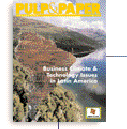Uncoated free-sheet: Prices up from ’98 lows with strong economy, lack of new capacity
GRADE STRUCTURE. Chemical pulps (sulfate, sulfite, soda, cotton linters, or vegetable fiber) are used to make uncoated free-sheet (also called woodfree) papers, with occasional additions of up to 10% mechanical fiber or bleached chemi-thermomechanical (BCTMP) pulps and recycled fibers. BCTMP furnishes lower the cost of manufacture while providing a better grade of paper than stone groundwood or other mechanical pulps. Many of the major producers have converted some or all of their machines to alkaline-based paper, and most new installations are alkaline.
Uncoated free-sheet papers are used for office and business printing (copiers, computer printers, etc.), business forms and envelopes, publishing (mostly text and trade books), commercial printing, and writing (stationery). There has been somewhat of an upheaval in the segment as cut-size demand is expected to grow two to three times faster than overall uncoated free-sheet demand, thanks to the rise of digital on-demand printing and sales of ink jet and laser printers.
U.S. shipments of uncoated free-sheet papers totaled 13.8 million tons in 1999, up 1.7% from 1998, according to the American Forest & Paper Assn. (AF&PA). Shipments from Canada were 112,000 mtons, an 8.7% increase from 1998, reports the Canadian Pulp & Paper Assn.
CAPACITY. According to AF&PA’s latest survey, U.S. uncoated free-sheet capacity is scheduled to increase 0.6% in 2000--adding 87,000 tons of new capacity--and remain essentially unchanged through 2002 at about 15.3 million tons. Only a few producers out of the dozens surveyed account for all the scheduled capacity gain in 2000, AF&PA said.
The survey excluded capacity shutdowns at several mills including Willamette Industries Inc. at Kingsport, Tenn. (22,000 tpy), and Mead Corp. at Rumford, Maine (105,000 tpy). Capacity is removed from the survey when it is dismantled or has been shut for at least a year.
Recently, there has been considerable reshuffling among uncoated free-sheet producers and their capacity rankings due to mergers and acquisitions. The biggest was the acquisition of Union Camp Corp. (formerly the first-largest) by International Paper Co., which was finalized in 1999. In 1998, Weyerhaeuser Co. acquired a large mill in Dryden, Ont., from Bowater Inc., and Domtar Inc. acquired E.B. Eddy Forest Products Ltd.
CURRENT MARKET CONDITIONS. The uncoated free-sheet market ended 1999 substantially higher than 1998 thanks to four price increases during the year. At year-end, cut-size (20-lb bond) was transacting about $860/ton, more than 20% higher than the year-ago month. Offset printing rolls (50-lb) were around $740/ton, up more than 25% from a seven-year low at the end of 1998.
A fifth price increase on uncoated free-sheet grades was announced for February and was being implemented at mid-month. Implementation dates and amounts varied by producer, but generally the hikes ranged from $40/ton to $60/ton and went into effect during the latter part of the month.
Industry sources said several factors were fueling the higher prices, including a tight pulp market, the continued strength of the U.S. economy, a lack of new production capacity coming online, and a pickup in demand in Asia, which has helped decrease the flow of offshore tons into the U.S.
OUTLOOK. Operating rates should move into the 95% to 96% range in second-half 2000 and 2001, leading to conditions that will favor two price hikes per year and perhaps more, according to Pulp & Paper Forecaster. The publication projects that prices will peak during third-quarter 2001 at $850/ton for offset rolls and $960/ton for cut-size copy paper.
By Nicola McIntoshNews Editor




